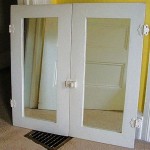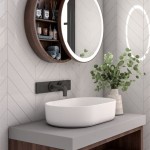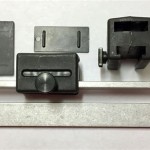Best Way to Hang a Heavy Frameless Mirror
Hanging a heavy, frameless mirror presents a unique set of challenges compared to hanging framed artwork. The weight and lack of a frame necessitate careful planning and execution to ensure the mirror is securely mounted and remains safely in place. Selecting the appropriate hanging hardware and following proper installation techniques are crucial for a successful and lasting result. Gravity constantly exerts force, and with frameless mirrors, this force is concentrated on the mounting points, increasing the importance of a robust system.
The absence of a frame means the weight of the mirror is distributed directly to the hardware attached to the glass. This requires specialized hardware designed to handle both the weight and the distribution of that weight across the mirror's surface. Unlike framed mirrors, there isn't a frame to help reinforce the structure and distribute the load, making the choice of mounting system paramount.
This article will detail the best methods for hanging a heavy, frameless mirror, focusing on hardware selection, preparatory steps, and installation techniques that prioritize safety and stability. A proactive approach, involving careful measurement and planning, lays the groundwork for a secure and aesthetically pleasing installation.
Understanding Weight and Wall Type
Before considering any hanging method, accurately determine the weight of the mirror. This information is usually available from the manufacturer or can be estimated by weighing the mirror on a bathroom scale. Knowing the weight is critical for selecting appropriate hardware with a sufficient weight rating. Exceeding the hardware's weight capacity poses a significant safety risk, potentially leading to the mirror falling and causing damage or injury.
Identifying the wall type is equally important. The hardware required for drywall differs significantly from that needed for plaster, concrete, or brick. Drywall, being a relatively soft material, requires anchors to distribute the weight over a larger surface area. Plaster, depending on its condition, may require similar considerations. Concrete and brick, on the other hand, are much more robust and can typically support heavier loads with appropriate masonry anchors.
To determine the wall type, a simple test can be performed in an inconspicuous area. Insert a small nail or screw into the wall. If it penetrates easily and the surrounding material crumbles, it is likely drywall. Plaster will offer more resistance, and concrete or brick will require specialized drilling. Understanding the wall composition allows for the selection of anchors that will grip the wall effectively and safely support the mirror's weight.
Incorrect anchor selection can lead to the mirror eventually pulling away from the wall. This is particularly concerning with heavy, frameless mirrors, where the consequences of failure can be severe. Consulting with a hardware professional can provide additional guidance tailored to specific wall types and weight requirements.
Selecting the Right Hanging Hardware
For hanging heavy, frameless mirrors, several specialized hardware options are available. These options prioritize a secure and subtle installation, minimizing the visibility of the hardware while ensuring the mirror remains firmly in place. The best choice depends on the mirror's size, weight, and the desired aesthetic.
Mirror Clips: Mirror clips are designed to grip the edges of the mirror and hold it securely against the wall. They are typically made of metal or plastic and come in a variety of styles, including adjustable and fixed options. For heavy mirrors, choose heavy-duty metal clips with a high weight capacity. Ensure the clips are appropriately sized to accommodate the mirror's thickness. Sufficient clearance around the mirror may be required to allow for installation and adjustment of the clips. The number of clips needed depends on the mirror's size and weight; consult the product specifications for recommended spacing.
The clips are typically secured to the wall using screws and anchors. Proper alignment and spacing of the clips are crucial for even weight distribution. Some mirror clips also offer the option of having the mirror rest on the lower clips like shelves, providing further security.
Mirror Mastic: While not used alone, mirror mastic is a construction adhesive specifically formulated for bonding mirrors to surfaces. It provides additional support and helps distribute the weight across a larger area. However, it's essential to use mirror mastic in conjunction with mechanical fasteners like mirror clips or Z-bar hangers, as adhesive alone may not be sufficient for heavy mirrors. Ensure the mastic is compatible with both the mirror's backing and the wall surface. Proper ventilation is also important when using mirror mastic.
Z-Bar Hangers: Z-bar hangers, also known as cleat hangers, offer a robust and discreet hanging solution. They consist of two interlocking metal strips, one attached to the back of the mirror and the other to the wall. The interlocking design distributes the weight evenly along the strip, providing a strong and secure hold. Z-bar hangers are particularly well-suited for heavy mirrors, as they can support significant weight. They also allow for easy adjustment of the mirror's position after installation.
The Z-bar attached to the mirror is typically secured with adhesive and mechanical fasteners. The Z-bar attached to the wall is secured using screws and anchors appropriate for the wall type. Proper leveling of the wall-mounted Z-bar is crucial for ensuring the mirror hangs straight.
Specialized Mirror Hanging Systems: Several manufacturers offer specialized mirror hanging systems specifically designed for frameless mirrors. These systems often incorporate a combination of hardware elements, such as clips, adhesive, and adjustable supports, to provide a comprehensive hanging solution. These systems often are more costly, but provide the highest level of safety and adjustability.
Regardless of the chosen hardware, always consult the manufacturer's instructions for proper installation and weight capacity. Overestimating the weight and using heavier-duty hardware than strictly necessary is always preferable to underestimating and risking a failure. Prioritizing quality hardware from reputable brands ensures a more secure and lasting installation.
Installation Techniques for a Secure Hanging
Once the appropriate hardware has been selected, meticulous preparation and installation are essential for a secure and professional-looking result. This process involves precise measurements, careful marking, and the use of appropriate tools.
Accurate Measurement and Marking: Begin by accurately measuring the desired location for the mirror on the wall. Use a level to ensure the mirror will hang straight. Mark the locations for the mounting hardware, accounting for the mirror's dimensions and the hardware's specifications. Double-check all measurements before proceeding. Inaccurate measurements can lead to misalignment and a less secure installation.
Pilot Holes and Anchors: For drywall or plaster walls, drill pilot holes at the marked locations, using a drill bit slightly smaller than the diameter of the chosen anchors. Insert the anchors into the pilot holes, ensuring they are flush with the wall surface. For concrete or brick walls, use a masonry drill bit to create pilot holes and insert appropriate masonry anchors. Confirm that the anchors are firmly seated and can withstand the expected weight load. The use of correct drill bits and anchors for the specific wall type is key to a secure installation.
Attaching Hardware to the Mirror: If using mirror mastic, apply it evenly to the back of the mirror, following the manufacturer's instructions. Avoid applying mastic too close to the edges, as it may squeeze out during installation. If using Z-bar hangers, attach one strip to the back of the mirror using adhesive and mechanical fasteners, ensuring it is level and securely attached. Allow the adhesive to cure completely before proceeding.
Mounting the Mirror: Carefully lift the mirror and align it with the mounting hardware on the wall. If using mirror clips, gently slide the mirror into the clips, ensuring it is securely held in place. If using Z-bar hangers, interlock the Z-bar attached to the mirror with the Z-bar attached to the wall. Use a level to confirm the mirror is hanging straight. Make any necessary adjustments to the hardware to ensure a perfect alignment. Avoid any sudden movements or excessive force during installation, as this could damage the mirror or the mounting hardware.
Final Inspection and Security Checks: Once the mirror is mounted, conduct a thorough inspection to ensure it is securely attached to the wall. Gently tug on the mirror to confirm there is no movement or instability. Inspect the mounting hardware for any signs of stress or looseness. If using mirror clips, ensure they are gripping the mirror firmly. If using Z-bar hangers, confirm the interlocking connection is secure. In the days following installation, periodically check the mirror and hardware to ensure everything remains secure. Addressing any minor issues promptly can prevent more significant problems later.
By following these guidelines, you can confidently and safely hang a heavy, frameless mirror, creating a visually appealing and secure addition to your space. Remember that safety should always be the top priority throughout the installation process.

How To Install A Mirror Without Frame Merrypad
:strip_icc()/DesireeBurnsInteriors1-f76d25cad90041c88fbae4a7dc10aab4.jpg?strip=all)
2 Simple Ways To Hang A Frameless Mirror

How To Hang A Frameless Mirror On The Wall With Pictures

How To Hang A Frameless Mirror On The Wall With Pictures

How To Install A Mirror Without Frame Merrypad

How To Hang A Frameless Mirror On Wall
:strip_icc()/ScreenShot2022-04-28at1.12.19PM-e055476c70c6438585fa7c5cd531edcf.png?strip=all)
4 Easy Ways To Hang A Heavy Mirror

How To Hang A Frameless Mirror June 2024 Your Guide Hanging

How To Hang A Hanging Mirror Without Accompanying Hardware

How To Hang A Frameless Mirror On The Wall With Pictures








